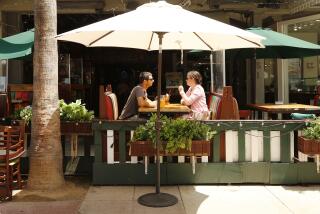Second-Guessing the Rates That Tour Companies Offer : Lodging: It pays to check if your operator is really getting you the best hotel price.
- Share via
On the whole, Dov B. Malkin of Los Angeles had a rewarding vacation in Peru in November. But he might have come home happier still had he not started asking questions at the hotels arranged by his tour operator. At one lodging in Lima, where Malkin and his fellow tour members were paying $78 nightly, Malkin found that similar rooms were available for $60 a night. At another hotel in the inland city of Cuzco, the travelers on Malkin’s tour paid $47 nightly, while guests off the street were paying $24.
This understandably troubled Malkin, and he laid out his case to me in a letter. His perplexity offers an important reminder for those who travel with tour groups: Tour operators can often negotiate attractive discounts with hotels because of their strength in numbers, and often mention such discounts in marketing their trips. But since tour operators seldom volunteer specific breakdowns of their package prices, travelers should pay close attention to itinerary details and package prices, or risk paying unnecessarily steep rates to inefficient or unscrupulous tour operators.
James J. Murphy, chairman of the U.S. Tour Operators Assn., estimates that large-scale tour operators pay 40%-70% of a hotel’s undiscounted “off-the-rack” rates, passing some of that savings along to customers. Individual travelers can’t count on doing that well, but a smart lodger generally can find a price substantially below a hotel’s “rack” rates, often by seeking out weekend specials at business hotels or off-season or mid-week rates at lodgings that rely on leisure travelers.
Murphy notes that the rates tour operators negotiate vary widely depending on the tour operator, the number of travelers he or she can deliver, the part of the world and the time of year. The tour operators who generally get the best rates, he says, are those who bring in a steady stream of groups--an arrival every week for two months, for instance--and who can predict the size of those groups with some specificity. Operators who tend to reserve more rooms than they later fill may get less advantageous rates from hotels.
Richard Launder, president of Garden Grove-based Contiki Holidays, notes that his negotiations with hotels often take place a full year in advance of the group’s arrival, and in cities like Los Angeles and Las Vegas can involve as many as 5,000 to 6,000 rooms yearly. In such circumstances, Launder says, a tour operator can get “fantastic” rates.
Some tour operators have cut out middlemen entirely by purchasing and operating their own lodgings--in Contiki’s case, a chateau in the Beaujolais region of France and a villa in Florence, Italy.
Conversely, Launder acknowledges, in areas where demand for accommodations far surpasses supply, tour operators have less bargaining strength, and may offer a narrower margin of advantage over the walk-in rates available to individual travelers. The Grand Canyon is one such place.
Generally, it doesn’t take too much work for a traveler to satisfy himself, or herself, that a tour operator is charging sensible rates. Before you buy a tour package, ask a travel agent how it stacks up against comparable itineraries offered by other tour operators, or call other operators yourself. To get into greater detail--though this could mean a lot of phone calls to hotels--take the overall tour price (excluding air fare) and divide it by the number of the nights you’ll spend in hotels. Then call the hotels to see what rate you would get as an independent traveler.
Before you jump to any conclusions about the numbers before you, consider several factors: On a tour, you’re usually paying also for the expertise of guides, ground transportation, and often meals and other services. Also, remember that most hotels in the United States, and many elsewhere, quote rates before taxes, which often boost the bill by 10%-20%. Keep in mind, too, that unexpectedly weak business can lead a hotel manager to drop prices to levels he or she wouldn’t have offered six months or a year earlier, when the tour contract was signed.
James Murphy’s company, Van Nuys-based Brendan Tours, is offering a six-night London trip next year, with lodgings at the Stakis St. Ermin’s Hotel between Victoria Station and Westminster Abbey. Using Brendan’s package tour, a couple would pay about $95 per person, per night (excluding air fare), and in the bargain receive free transportation to and from the airport, continental breakfasts, a two-day public transportation pass, a welcome drink, a half-day sightseeing tour, and a pair of theater tickets valued at $50 each. The hotel’s published “rack” rates, meanwhile, work out to roughly $115 per person per night, double occupancy. A better price (about $88 per person, per night) is available if that couple reserves a St. Ermin’s room via a toll-free call to Utell, the hotel’s U.S. booking agents--but that rate includes no extras.
Independent travelers often can get further discounts by calling overseas hotels directly. But tour operators may be able to arrange air fares at better prices, and tour groups offer freedom from logistical wrangling and the clout of an international organization that can swing into action in a medical crisis or emergency.
More to Read
Sign up for The Wild
We’ll help you find the best places to hike, bike and run, as well as the perfect silent spots for meditation and yoga.
You may occasionally receive promotional content from the Los Angeles Times.







